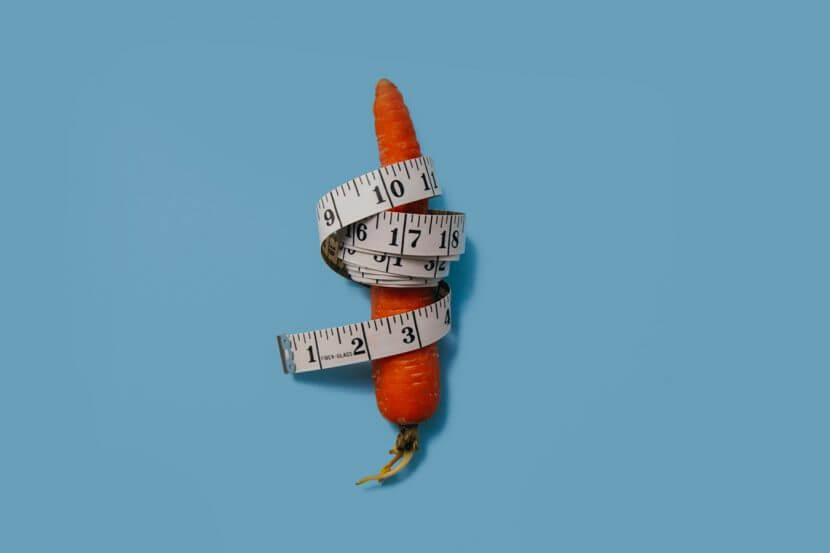Food portions have increased dramatically in the last 10 years. Today, we’re being greatly overserved—just look at the typical restaurant meal, which can easily serve two or more people! And unfortunately, these portion sizes are taking a toll on our health.
Thankfully, eating a healthy, satiating diet (like the Keto Zone Diet) provides natural appetite suppression and portion control. However, it’s always good to have a few extra tricks up your sleeve to prevent overeating.
Here are some ways you can “hack” your eyes and your appetite into naturally eating smaller food portions.
1. EAT AT HOME MOST OF THE TIME
When you cook and prepare your own meals, you can control the food portions. It’s much easier to eat less when having a home-cooked meal versus a restaurant meal. At home, you’re not automatically served a huge plate of food that likely has added sugars, salts, and carbs to make it more appealing.
Find healthy recipes that are nutrient-dense, low in carbs and sugars, and easy to prepare at home.
2. LEARN THE BASIC FOOD PORTIONS
Knowing general food portion sizes for common foods gets you familiar with a proper serving. Here are some simple serving sizes:
- Meats: 3 ounces
- Fish: 6 ounces, cooked
- Nuts: 1 ounce
- Cooked vegetables: ½ cup
- Leafy green or raw vegetables: 1 cup
- Fruits: 1 medium banana, apple, pear or orange; 1 cup diced fruit; 1 cup berries
A quick Google search can give you instant portion sizes for most foods. Keeping these in the back of your mind can make it easier to self-regulate, even if it’s a cheat day.
3. USE SMALLER PLATES AND BOWLS
Your eyes can have a powerful effect on hunger and fullness. Research shows even a small increase in the size of dishware can lead to significantly more calorie intake [1]. And even the size of dinner plates have increased along with food portions over the years.
So, you can actually “trick” your eyes and brain into thinking you have more food by using smaller plates and bowls!
- Instead of using a dinner plate for your meal, put it on a salad plate.
- Use a rice bowl instead of a normal-sized bowl.
- Use smaller spoons, forks, and other silverware to decrease the size of each bite.
This can work in the reverse way too. If you need to eat more low carb vegetables, for example, but have trouble getting enough, using a larger plate or bowl can encourage you to eat more of them.
4. EAT ENOUGH FAT AND PROTEIN
Satiety matters when it comes to food portions. Fill up on healthy fats and proteins, and you’re much less likely to overeat than the average American. That includes:
- Healthy keto fats like olive oil, nuts and seeds, avocado, and grass-fed butter to keep you satisfied and less likely to crave other foods
- Healthy proteins like grass-fed meats, fatty fish, dairy, and eggs to increase feelings of fullness and help with weight loss [2,3]
- Having 20-30 grams of protein with breakfast to decrease appetite and control food portions throughout the day.
You can also reduce overeating by having plenty of low carb vegetables and drinking lots of water.
5. AVOID SNACKING—ESPECIALLY AT NIGHT
Snacking can easily turn into too much, so try to limit or avoid snacking in between meals. And plan to make dinner your last food for the day.
Intermittent fasting can also help you avoid late-night snacking that packs on the pounds. Plus, you get the many benefits of fasting too.
6. DO SOME MEAL PLANNING
Even a little meal prepping helps control food portions. You can plan out each meal and divide it into servings beforehand to reduce overeating or impulse eating.
7. PRACTICE MINDFUL EATING
Lastly, remember to stay mindful when enjoying your food. A lot of eating too much comes down to mindless grazing or binging.
Aim to fully focus on your meals:
- Enjoy the tastes, textures, and smells of the food you’re eating.
- Choose foods that you know are doing your body good and fueling good health.
- Try to eat without many distractions so you can pay attention to your hunger and fullness signals.
- Say a quick prayer of thanks and gratitude before each meal, acknowledging the blessings of a healthy meal.
Even a small change in food portions over time can make a big difference in weight loss and health goals. Above all, what matters most is the quality of the foods you’re eating. But if you’re prone to overeating and struggle with portion control, these tips can help a lot.

Thank you, great ideas on bringing food/diet into balance!
What would cause my muscles to hurt.? I use to get Charlie horses in my legs but now instead my muscle on my left elbow hurts and my shoulders hurt. ?
HI Patricia,
Unfortunately we don’t answer any kind of medical questions.We recommend you to consult your physician for any kind of medical advice.
I hope this helps!
Thank You for choosing Divine Health
For Patricia Rosenbrook having problems with Charlie horses in your legs and other pain in your elbow and shoulders….I got relief from taking an epsom salt bath – 2 Cups of salt in a bathtub of warm water. I know that the filtration system on our water takes the magnesium (much needed) out of our water. Epsom salts is magnesium caltrate I believe and my body soaked it up relaxing the tense magnesium deficient muscles. Hope this tip works for you as well as it does for me. Now I do that once a week, even if it’s just soaking my feet.